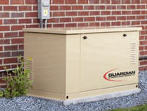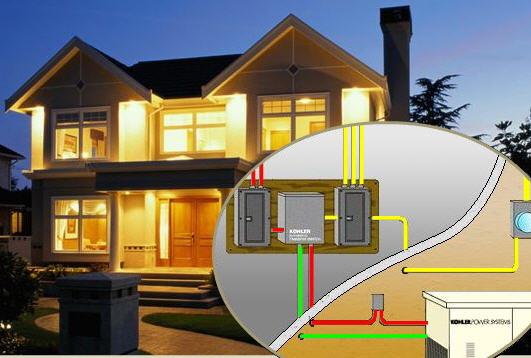Standby Power Generation
Standby Power Generation
Overview
For many years only the most wealthy home owners have been able to afford automatic standby generators for their home’s electric power needs. New products, lower relative prices, and the ever increasing dependance on electric power has made the standby genset a much more common home appliance.
Standby gensets are rated according to their kilowatt (kW) of capacity; the higher the kW rating, the larger the unit and the more load it can carry.
Most houses should be equipped with a 5 – 10 kW genset.
- 5 kW will carry an average house lighting and appliance load
- 10 kW should be considered for houses with their own water well pump
- 15 kW should be considered for house that also desire to run their air conditioning systems
If you plan to install a new standby genset that will be capable of running your natural gas furnace during a power outage, check with your natural gas company to be sure your gas service and meter has the capacity to supply BOTH the new genset and gas furnace at the same time. Also, most gas utilities will not supply increased gas pressure just to run a standby genset. Therefore, be sure to select a unit and size the gas piping to be able to operate on standard delivery pressure, which is typically 0.25 psi or 7″ WC.
Operation
A standby generator should be installed by a qualified electrician.
An electric sub-panel and switching system (middle gray box) automatically senses when the grid power fails (yellow) and turns on (green) the standby genset, which is normally powered by natural gas or propane.
The switch/ sub-panel (left gray box) allows power to flow to the house circuits (red), but not the utility grid. Depending on the size of the genset, it may power the entire house, or just certain pre-determined circuits – such as those for lighting and appliances.
The control system continues to monitor the electric grid (yellow) while the generator provides power to the house (red). When the electric grid returns to power, the genset is automatically turned off (green).
Most units also have self-test feature that starts the unit one a week or month to assure that it is ready to run when needed.
Cost of Operation
Although operating cost is generally not a concern, standby gensets require about 15,000 BTUs per kW of rating.
Therefore, a 10 kW unit would require about 150,000 BTUs per hour and cost about $1.73 per hour to operate when natural gas costs $1.15/CCF.
Benefits of Automatic Standby -vs- Portable Units
- Completely Automatic
- Restores power within a minute (or so)
- Operates whether you are home or away
- No gasoline to purchase, transport or store
- No power cords
- Can power the entire house or just select loads
- Quiet operation
- Self-testing
- Safer operation
- Professionally installed
Manufacturers
 Generac Power Systems
Generac Power Systems
Hwy. 59 & Hillside Road
P.O. Box 8
Waukesha, WI 53187
Go to the Generac web site at
www.guardiangenerators.com/consumerHome.asp
 Kohler Power Systems
Kohler Power Systems
Kohler, Wisconsin
Telephone: 800-544-2444
Got to the Kohler web site at www.kohler.com
 Onan
Onan
1-800-888-ONAN (1-800-888-6626)
Go to the Onan web site at www.onan.com

